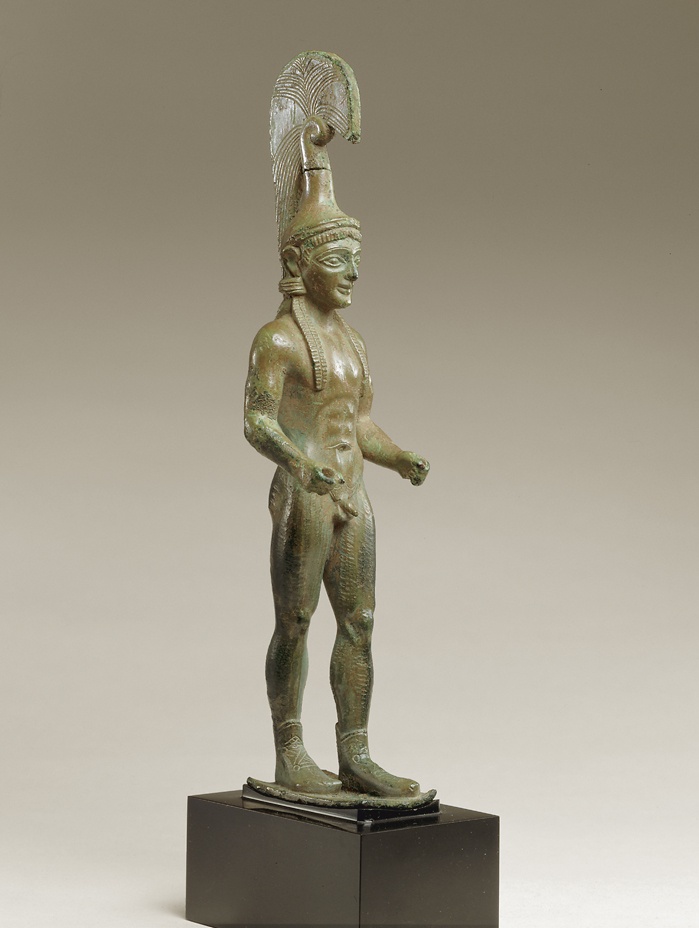
Bronze
H: 19.6 cm
Allegedly from Greece, Olympia?
North-East Peloponnesian, Sicyon?
c. 520 B.C.
Ex collection: Jorge Ortiz Linares (1954-1965) [1]
Solid-cast by the lost wax process and carefully worked in the cold with delicate engraving and chasing.
Condition: crack through the helmet crest support, surface abraded. Green patina with traces of reddish earth.
We know of no valid comparison for this youth which would help either to explain him or to locate his school.
He is not an ordinary warrior, for in addition to being naked, he wears boots and a helmet.
His footwear is interesting, various elements represented realistically but combined in an unrealistic fashion. The low boots are of the endromides [2] type, soleless and of soft leather, the shaft reaches to the calf with a wide V [3] above the ankles. The lacing and tongue are figured on the front of the boots for a decorative purpose, as though a gabled window - the lacing threaded through four eyelets that criss-cross with two simple ties. In reality they should reach to the top of the shaft to make the boots wearable.
His decorative Attic-type helmet is surmounted by an imposing high crest for which an interesting comparison is a Palladion [4] from Tegea in Arcadia, variously considered Laconian or an Arcadian imitation [5]. Though far shorter, the element supporting the crest of the Athena terminates in the same volute and the crest itself is very similar in shape, with the same pattern of horsehair engraving save for the part of the crest falling down the back. Also, the engraved circles on the volute and the edge of Athena's peplos are like the one above each ear on the helmet of our youth and for the eyelets on his boots.
We can draw no conclusions from the above though a distant rapport is probable.
Langlotz conjectured a Sicyonian school and by elimination this seems the most likely attribution for the youth, though one should not totally exclude the possibility that he was an unusual Attic creation.
He may have held a spear in each hand and represents a hero or athlete dedicated as a votive.
Exhibited and Published:
Meisterwerke griechischer Kunst, cat. no. IV 173,
pp. 176, 181 ill.
Master Bronzes, cat. no. 38, p. 55 ill. (Hoffmann, H.: Apollo 86, 69, November 1967, no. 4, p. 334).
Primitive to Picasso, cat. no. 12, pp. 20, 96 ill.
Hommes et Dieux, cat. no. 134, pp. 217, 216 ill., p. 215 col. pl.
Published:
Charbonneaux, J.: Les bronzes grecs (Paris, 1958),
pp. 69, 141 pl. 8,1.
Häfner, U.: Das Kunstschaffen Lakoniens (Münster, 1965),
p. 158.
Mentioned:
Gjödesen, M.: Greek Bronzes. A review article, AJA 67, 1963, p. 334. - Jost, M.: Statuettes de bronze de Lykosoura, BCH 99, 1975, p. 357 n. 68. - Jucker, H.: Der archaische griechische Standspiegel in Cincinnati, in: In Memoriam Otto J. Brendel (Mainz, 1976), p. 32 n. 46. - Walter-Karydi, E.: Bronzen aus Dodona, JbBerlMus 23, 1981, p. 31 n. 42. - Richardson, E.: Etruscan Votive Bronzes (Mainz, 1983), p. 177 n. 17. - Herfort-Koch, M. Archaische Bronzeplastik Lakoniens, Boreas Beiheft 4, 1986, p. 58 n. 206. - Kozloff, A.P., Mitten, D.G. (eds.): The Gods Delight. The Human Figure in Classical Bronze (Cleveland, 1988), pp. 84, 86.
Archaeology Glossary
1 Father of George Ortiz and understandingly acquired at the latter's request.
2 For footwear in general consult: Morrow, K.D.: Greek Footwear and the Dating of Sculpture (Madison, 1985).
3 For an example of this, see a boot of a terracotta
equestrian figure from the Athenaion in Gela (ASAtene 27-29, 1949-1951, pl. 5).
4 Athens, National Museum 14828.
5 Rolley, Cl.: Les bronzes grecs (Fribourg, 1983), p. 112 fig. 95.